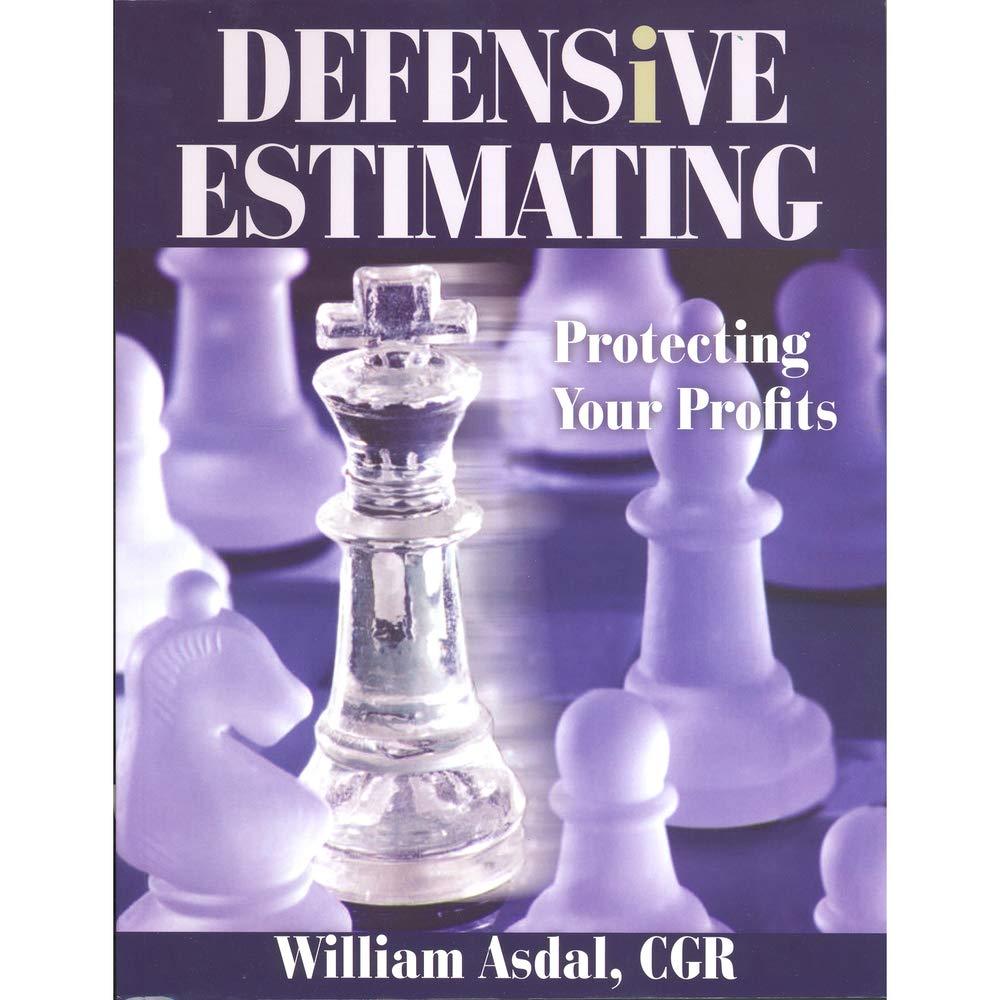Answered step by step
Verified Expert Solution
Question
1 Approved Answer
I only need the answer to 7 CableTech Bell Corporation (CTB) operates in the telecommunications industry. CTB has two divisions: the Phone Division and the

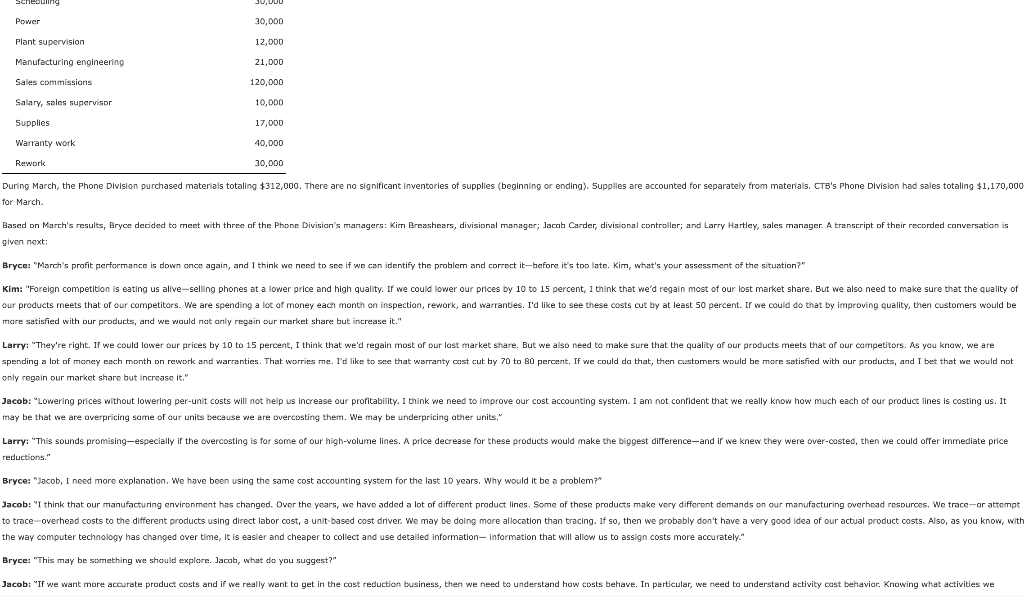
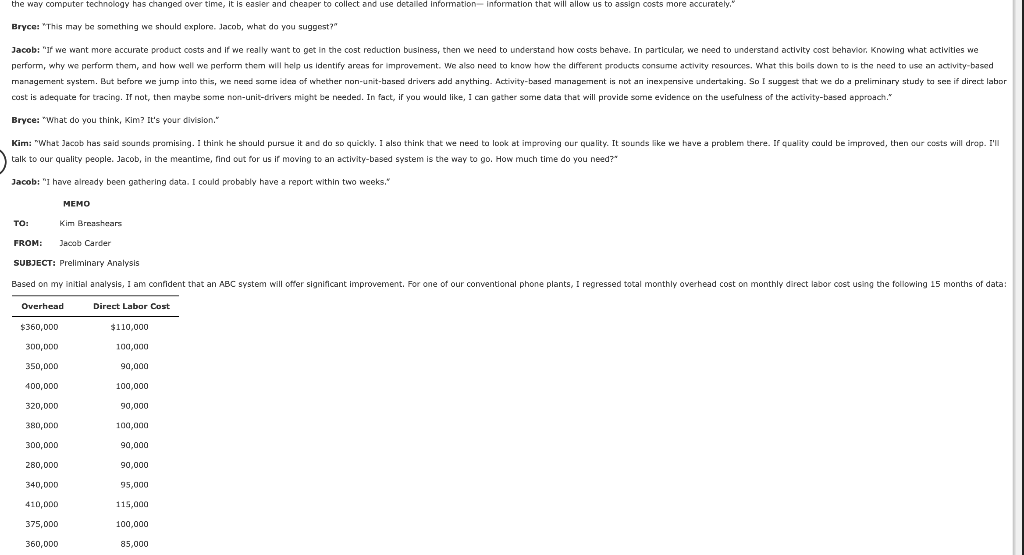
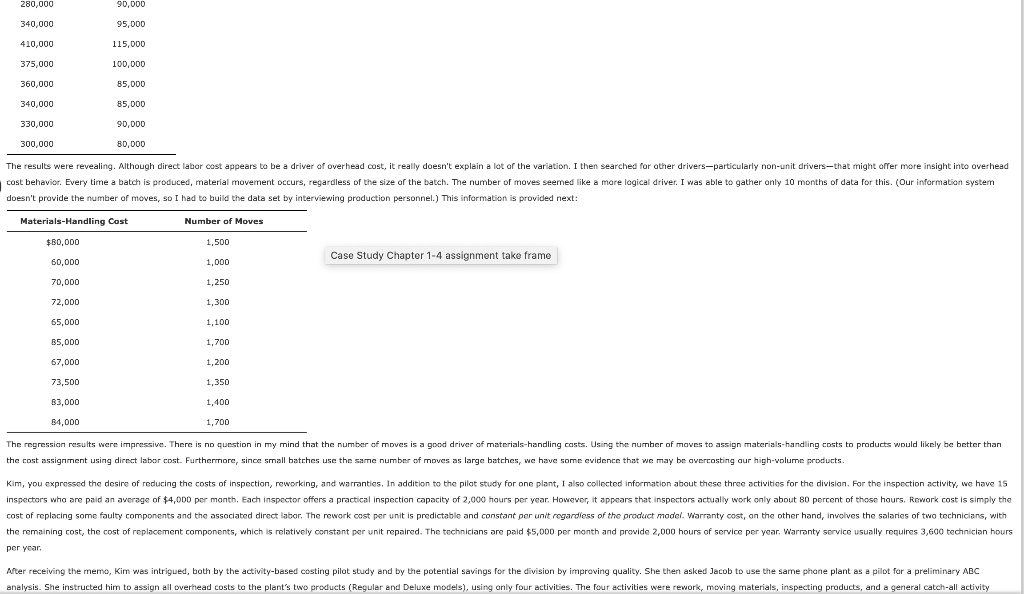
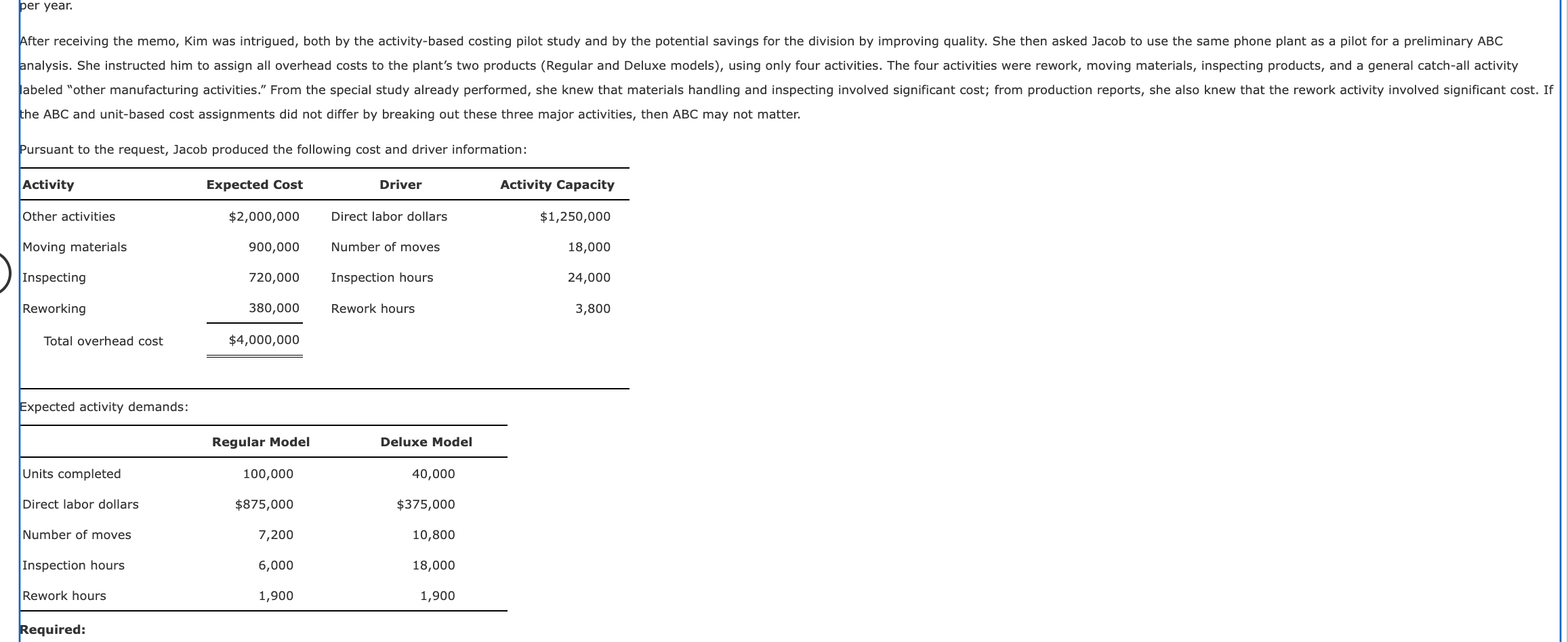
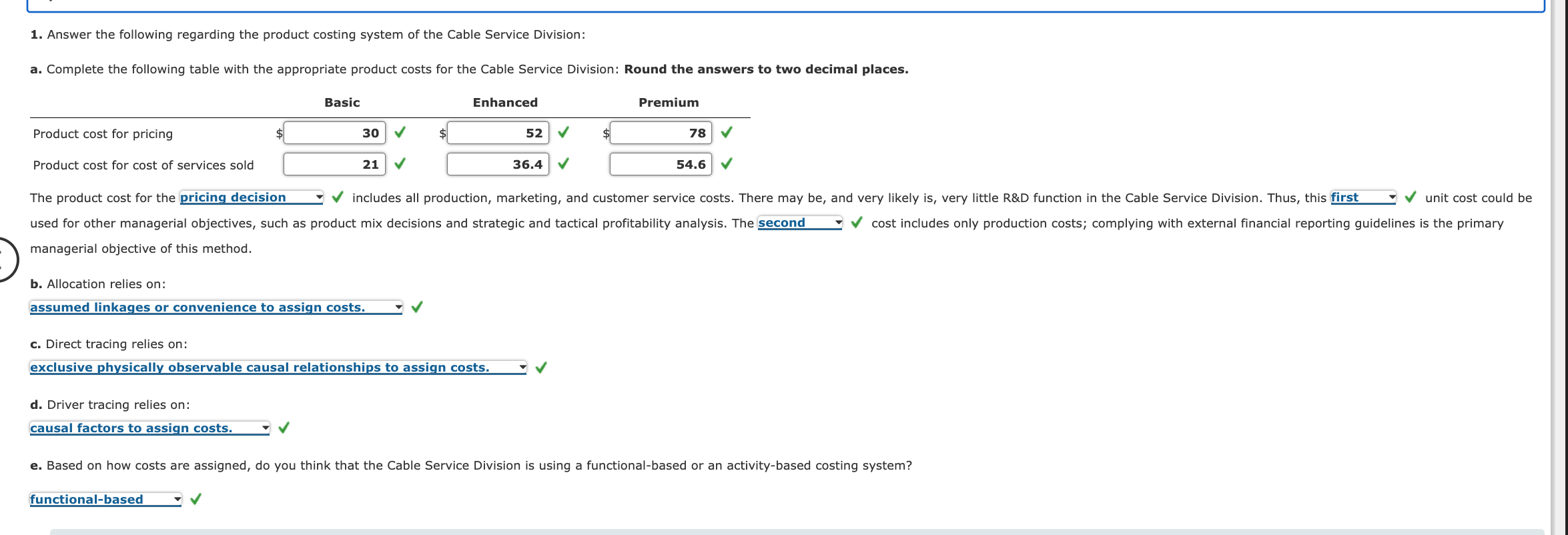
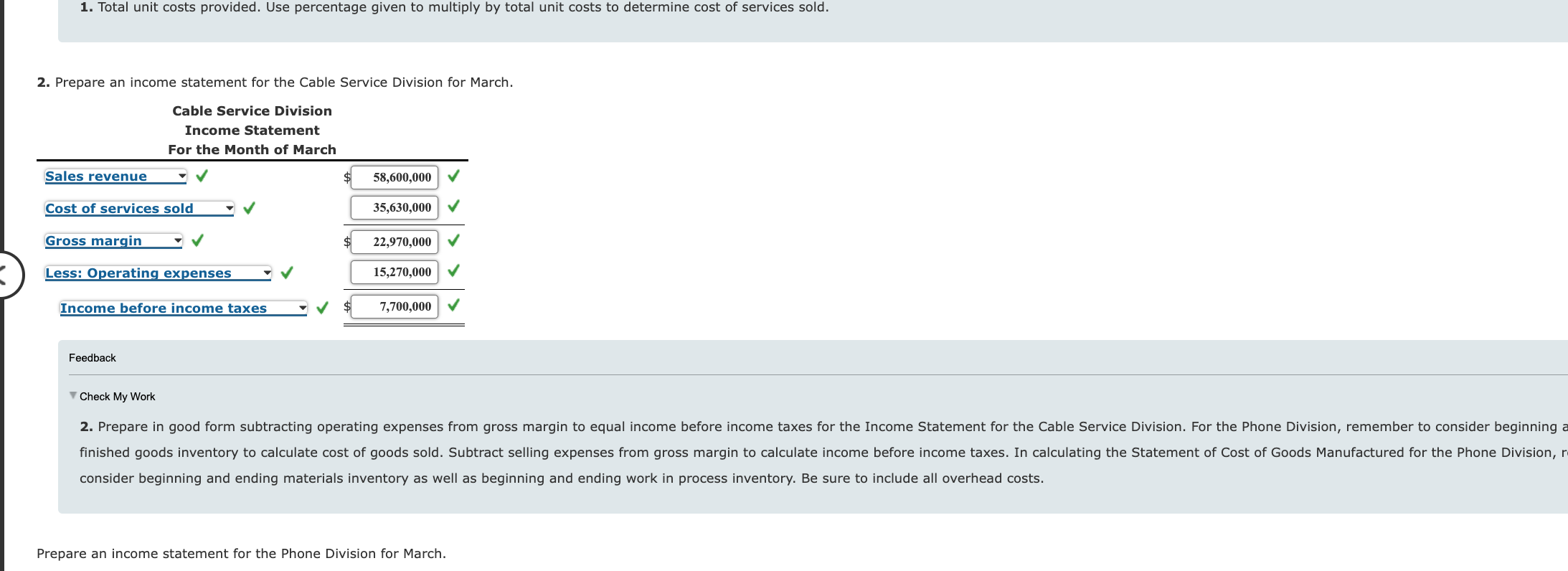
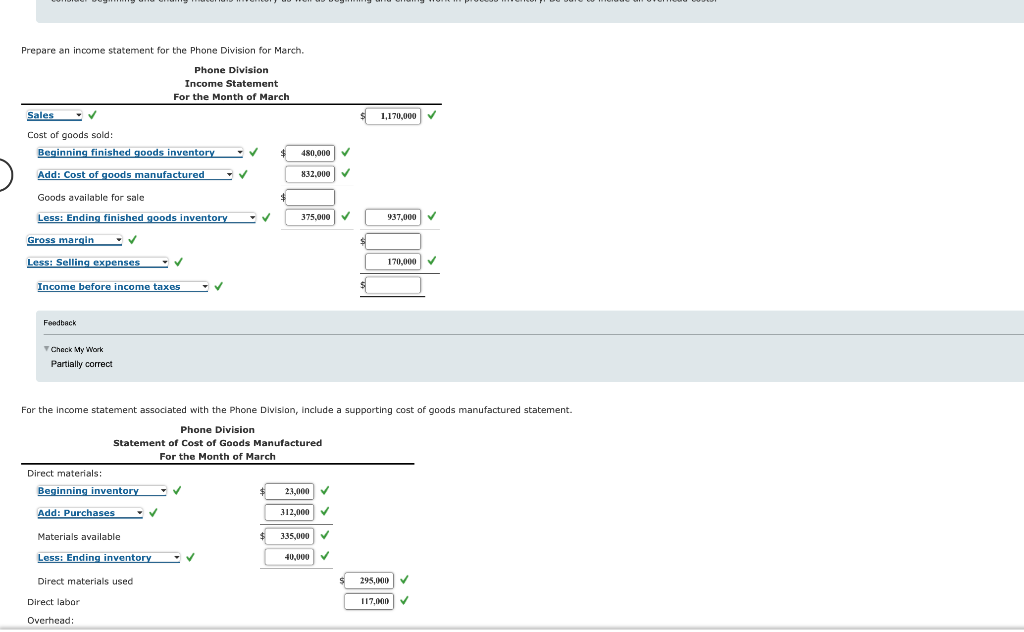

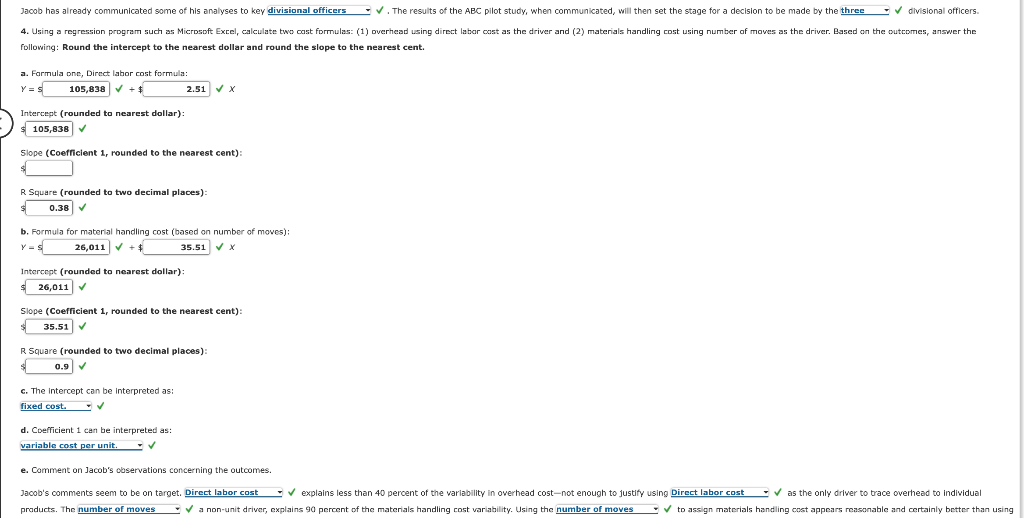
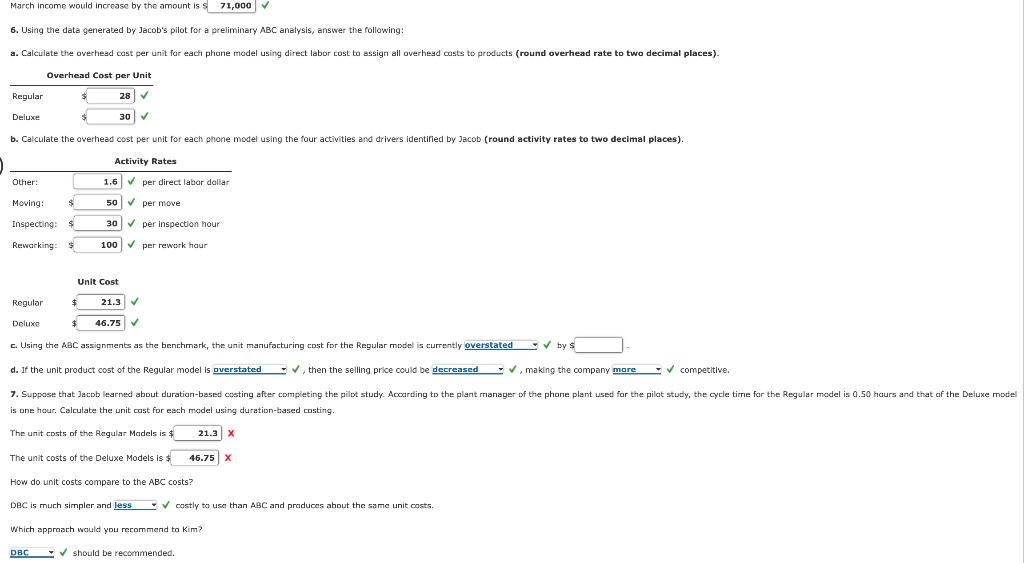
I only need the answer to 7
CableTech Bell Corporation (CTB) operates in the telecommunications industry. CTB has two divisions: the Phone Division and the Cable Service Division. The Phone Division manufactures telephones in several plants located in the Midwest. The product lines run from relatively inexpensive touch-tone wall and desk phones to expensive, high-quality cellular phones. CTB also operates a cable TV service in Ohio. The Cable Service Division offers three products: a basic package with 25 channels; an enhanced package, which is the basic package plus 35 additional channels and two movie channels; and a premium package, which is the basic package plus 55 additional channels and six movie channels. The Cable Service Division reported the following activity for the month of March: Basic Enhanced Premium Sales (units) 50,000 500,000 300,000 Price per unit $32 $50 90 Unit costs: Directly traced $5 $18 $36 Driver traced $4 $B $12 Allocated $20 $26 $30 The unit costs are divided as follows: 70 percent production and 30 percent marketing and customer service. Direct labor cast is the only driver used for tracing. Typically, the division uses only production costs to define unit costs. The preceding unit product cost information was provided at the request of the marketing manager and was the result of a special study. Bryce Youngers, the president of CTB, is reasonably satisfied with the performance of the Cable Service Division. March's performance is fairly typical of what has been happening over the past two years. The Phone Division, however, is anather matter. Its overall profit performance has been declining. Twa years ago, income before income taxes had been about 25 percent of sales. March's dismal performance was also typical for what has been happening this year and is expected to continue- unless some action by management is taken to reverse the trend. During March, the Phanc Division reported the following results: Inventories: Materials, March 1 $23,000 Materials, March 31 40,000 Work in process, March 1 130,000 Work in process, March 31 45,000 Finished goods, March 1 480,000 Finished goods, March 31 375,000 Costs: Direct labor $117,000 Plant and equipment depreciation 50,000 Materials handling 85,000 Inspections 60,000 Scheduling 30,000 Power 30,000 Plant supervision 12.000 Schebung Power 30,000 Plant supervision 12,000 Manufacturing engineering 21,000 Sales commissions 120,000 Salary, sales supervisor 10,000 Supplies 17,000 Warranty work 40,000 Rework 30,000 During March, the Phone Division purchased materials totaling $312,000. There are no significant inventories of supplies (beginning or ending). Supplies are accounted for separately from materials. CTB's Phone Division had sales totaling $1,170,000 for March Based on March's results, Bryce decided to meet with three of the Phone Division's managers: Kim Breashears, divisional manager; Jacob Carder, divisional controller; and Larry Hartley, sales manager. A transcript of their recorded conversation is given next: Bryce: "March's profit performance is down once again, and I think we need to see if we can identify the problem and correct it-before it's too late. Kim, what's your assessment of the situation?" Kim: "Foreign competition is eating us alive-selling phones at a lower price and high quality. If we could lower our prices by 10 to 15 percent, I think that we'd regain most of our lost market share. But we also need to make sure that the quality of our products meets that of our competitors. We are spending a lot of money each month on inspection, rework, and warranties. I'd like to see these costs cut by at least 50 percent. If we could do that by improving quality, then customers would be mare satisfied with our products, and we would not only regain our market share but increase it." Larry: 'They're right. If we could lower our prices by 10 to 15 percent, I think that we'd regain most of our last market share. But we also need to make sure that the quality of our products meets that of our competitors. As you know, we are spending a lot of money each month on rework and warranties. That worries me. I'd like to see that warranty cost cut by 70 to 80 percent. If we could do that, then customers would be more satisfied with our products, and I bet that we would not only regain our market share but increase it. Jacob: "Lowering prices without lowering per-unit costs will not help us increase our profitability. I think we need to improve our cost accounting system. I am not confident that we really know how much each of our product lines is costing us. It may be that we are overpricing some of our units because we are overcosting them. We may be underpricing ather units." Larry: 'This sounds promising-especially if the overcosting is for some of our high-volume lines. A price decrease for these products would make the biggest difference and if we knew they were over-casted, then we could offer immediate price reductions." Bryce: "Jacob, I need more explanation. We have been using the same cost accounting system for the last 10 years. Why would it be a problem? Jacob: "I think that our manufacturing environment has changed. Over the years, we have added a lot of different product lines. Some of these products make very different demands on our manufacturing overhead resources, We trace-or attempt to trace-overhead costs to the different products using direct labor cost, a unit-based cost driver. We may be doing more allocation than tracing. If so, then we probably don't have a very good idea of our actual product costs. Also, as you know, with the way computer technology has changed over time, it is easier and cheaper to collect and use detailed information, information that will allow us to assign costs more accurately." Bryce: "This may be something we should explore. Jacab, what do you suggest?" Jacob: "If we want more accurate product costs and if we really want to get in the cost reduction business, then we need to understand how costs behave. In particular, we need to understand activity cast behavior. Knowing what activities we the way computer technology has changed over time, it is easier and cheaper to collect and use detailed information-information that will allow us to assign costs more accurately." Bryce: 'This may be something we should explore. Jacob, what do you suggest?" Jacob: "If we want more accurate product costs and if we really want to get in the cost reduction business, then we need to understand how costs behave. In particular, we need to understand activity cost behavior. Knowing what activities we perform, why we perform them, and how well we perform them will help us identify areas for improvement. We also need to know how the different products consume activity resources. What this boils down to is the need to use an activity-based management system. But before we jump into this, we need some idea of whether non-unit-based drivers add anything. Activity-based management is not an inexpensive undertaking. So I suggest that we do a preliminary study to see if direct labor 1 cost is adequate for tracing. If not, then maybe some non-unit-drivers might be needed. In fact, if you would like, I can gather some data that will provide some evidence on the usefulness of the activity-based approach. Bryce: "What do you think, Kim? It's your division." Kim: "What Jacob has said sounds promising. I think he should pursue it and do so quickly. I also think that we need to look at improving our quality. It sounds like we have a problem there. If quality could be improved, then our costs will drop. I'll talk to our quality people. Jacob, in the meantime, find out for us if moving to an activity-based system is the way to go. How much time do you need? Jacob: "I have already been gathering data. I could probably have a report within two weeks. MEMO : Kim Breashears FROM: Jacob Carder SUBJECT: Preliminary Analysis Based on my initial analysis, I am confident that an ABC system will offer significant improvement. For one of our conventional phone plants, I regressed total monthly overhead cost on monthly direct labor cost using the following 15 months of data Overhead Direct Labor Cost $360,000 $110,000 300,000 100,000 350,000 90,000 400,000 100.000 320,000 90,000 380,000 100,000 300,000 90,000 280,000 90,000 340,000 95.000 410,000 115,000 375,000 100,000 360,000 85,000 280,000 90,000 340,000 95,000 410,000 115,000 375,000 100,000 360,000 85,000 340,000 85,000 330,000 90,000 300.000 80,000 The results were revealing. Although direct labor cost appears to be a driver of overhead cost, it really doesn't explain a lot of the variation. I then searched for other drivers particularly non-unit drivers-that might offer more insight into overhead cost behavior. Every time a batch is produced, material movement occurs, regardless of the size of the batch. The number of moves seemed like a mare logical driver. I was able to gather only 10 months of data for this. (Our information system doesn't provide the number of moves, so I had to build the data set by interviewing production personnel.) This information is provided next: Materials-Handling Cost Number of Moves $80,000 1,500 60,000 Case Study Chapter 1-4 assignment take frame 1,000 70,000 1,250 72,000 1,300 65,000 1,100 85,000 1,700 67,000 1,200 73,500 1,350 83,000 1,400 84,000 1,700 The regression results were impressive. There is no question in my mind that the number of moves is a good driver of materials-handling costs. Using the number of moves to assign materials-handling costs to products would likely be better than the cost assignment using direct labor cost. Furthermore, since small batches use the same number of moves as large batches, we have some evidence that we may be avercosting aur high-volume products. Kim, you expressed the desire of reducing the costs of inspection, reworking, and warranties. In addition to the pilot study for one plant, I also collected information about these three activities for the division. For the inspection activity, we have 15 inspectors who are paid an average of $4,000 per month. Each inspector offers a practical inspection capacity of 2,000 hours per year. However, it appears that inspectors actually work only about 80 percent of those hours. Rework cost is simply the cost of replacing some faulty components and the associated direct labor. The rework cost per unit is predictable and constant per unit regardless of the product model. Warranty cost, on the other hand, involves the salaries of two technicians, with the remaining cost, the cost of replacement components, which is relatively constant per unit repaired. The technicians are paid $5,000 per month and provide 2,000 hours of service per year. Warranty service usually requires 3,600 technician hours per year After receiving the memo, Kim was intrigued, both by the activity-based costing pilot study and by the potential savings for the division by improving quality. She then asked Jacob to use the same phone plant as a pilot for a preliminary ABC analysis. She instructed him to assign all overhead costs to the plant's two products (Regular and Deluxe models), using only four activities. The four activities were rework, moving materials, inspecting products, and a general catch-all activity per year. After receiving the memo, Kim was intrigued, both by the activity-based costing pilot study and by the potential savings for the division by improving quality. She then asked Jacob to use the same phone plant as a pilot for a preliminary ABC analysis. She instructed him to assign all overhead costs to the plant's two products (Regular and Deluxe models), using only four activities. The four activities were rework, moving materials, inspecting products, and a general catch-all activity Jabeled "other manufacturing activities." From the special study already performed, she knew that materials handling and inspecting involved significant cost; from production reports, she also knew that the rework activity involved significant cost. If the ABC and unit-based cost assignments did not differ by breaking out these three major activities, then ABC may not matter. Pursuant to the request, Jacob produced the following cost and driver information: Activity Expected Cost Driver Activity Capacity Other activities $2,000,000 Direct labor dollars $1,250,000 Moving materials 900,000 Number of moves 18,000 Inspecting 720,000 Inspection hours 24,000 Reworking 380,000 Rework hours 3,800 Total overhead cost $4,000,000 Expected activity demands: Regular Model Deluxe Model Units completed 100,000 40,000 Direct labor dollars $875,000 $375,000 Number of moves 7,200 10,800 Inspection hours 6,000 18,000 Rework hours 1,900 1,900 Required: 1. Answer the following regarding the product costing system of the Cable Service Division: a. Complete the following table with the appropriate product costs for the Cable Service Division: Round the answers to two decimal places. Basic Enhanced Premium Product cost for pricing 30 $ 52 78 Product cost for cost of services sold 21 36.4 54.6 The product cost for the pricing decision includes all production, marketing, and customer service costs. There may be, and very likely is, very little R&D function in the Cable Service Division. Thus, this first unit cost could be used for other managerial objectives, such as product mix decisions and strategic and tactical profitability analysis. The second cost includes only production costs; complying with external financial reporting guidelines is the primary managerial objective of this method. b. Allocation relies on: assumed linkages or convenience to assign costs. c. Direct tracing relies on: exclusive physically observable causal relationships to assign costs. d. Driver tracing relies on: causal factors to assign costs. e. Based on how costs are assigned, do you think that the Cable Service Division is using a functional-based or an activity-based costing system? functional-based 1. Total unit costs provided. Use percentage given to multiply by total unit costs to determine cost of services sold. 2. Prepare an income statement for the Cable Service Division for March. Cable Service Division Income Statement For the Month of March Sales revenue 58,600,000 Cost of services sold 35,630,000 Gross margin 22,970,000 Less: Operating expenses 15,270,000 Income before income taxes 7,700,000 Feedback Check My Work 2. Prepare in good form subtracting operating expenses from gross margin to equal income before income taxes for the Income Statement for the Cable Service Division. For the Phone Division, remember to consider beginning a finished goods inventory to calculate cost of goods sold. Subtract selling expenses from gross margin to calculate income before income taxes. In calculating the Statement of Cost of Goods Manufactured for the Phone Division, consider beginning and ending materials inventory as well as beginning and ending work in process inventory. Be sure to include all overhead costs. Prepare an income statement for the Phone Division for March. Prepare an income statement for the Phone Division for March. Phone Division Income Statement For the Month of March Sales $ 1,170,000 480,000 832.000 Cost of goods sold: Beginning finished goods inventory Add: Cost of goods manufactured : Goods available for sale Less: Ending finished goods inventory 375.000 937,000 Gross margin Less: Selling expenses 170,000 Income before income taxes $ Feedback Check My Work Partially correct For the income statement associated with the Phone Division, include a supporting cost of goods manufactured statement. Phone Division Statement of Cost of Goods Manufactured For the Month of March Direct materials: Beginning inventory 23,000 Add: Purchases 312,000 Materials available 335,000 Less: Ending inventory 40,000 Direct materials used 295,000 Direct labor 117,000 Overhead: Direct labor 117,000 Overhead: Plant and equipment depreciation Materials handling Inspections Scheduling Power Plant supervision Manufacturing engineering Supplies Rework 335,000 Total manufacturing costs added: 747,000 Add: Beginning work in process 130,000 Less: Ending work in process 375,000 Cost of goods manufactured blank 832,000 Jacob has already communicated some of his analyses to key divisional officers. The results of the ABC pilot study, when communicated, will then set the stage for a decision to be made by the three divisional officers. 4. Using a regression program such as Microsoft Excel, calculate two cast formulas: (1) overhead using direct labor cast as the driver and (2) materials handling cost using number of moves as the driver. Based on the outcomes, answer the following: Round the intercept to the nearest dollar and round the slope to the nearest cent. a. Formula One, Direct labor cost formula: Y = 5 105,838 + 2.51 x Intercept (rounded to nearest dollar): $ 105,838 Slope (Coefficient rounded to the nearest cent): R Square (rounded to two decimal places) 0.38 b. Formula for material handling cost (based on number of moves): Y-S 26,011 + + 35.51 x Intercept (rounded to nearest dollar) $ 26,011 rounded to the nearest cent): Slope (Coefficient 35.51 R Square (rounded to two decimal places) 0.9 C. The intercept can be interpreted as: fixed cost. d. Coefficient 1 can be interpreted as: variable cost per unit. e. Comment on Jacob's observations concerning the outcomes. Jacob's comments seem to be on target. Direct labor cost explains less than 40 percent of the variability in overhead cost-not enough to justify using Direct labor cost as the only driver to trace overhead to individual products. The number of moves a non-unit driver, explains 90 percent of the materials handling cost variability. Using the number of moves to assign materials handling cost appears reasonable and certainly better than using March income would increase by the amount is s 71,000 6. Using the data generated by Jacob's pilot for a preliminary ABC analysis, answer the following: a. Calculate the overhead cast per unit for each phone model using direct labor cost to assign all overhead costs to products (round overhead rate to two decimal places). Overhead Cost per Unit Regular 28 Deluxe $ 30 b. Calculate the overhead cost per unit for each phone model using the four activities and drivers identified by Jacob (round activity rates to two decimal places). Activity Rates Other: 1.6 per direct labor dollar Moving: $ 50 per move Inspecting 30 per inspection hour 100 per rework haur Rewarking: Unit Cost Regular $ 21.3 Deluxe $ 46.75 c. Using the ABC assignments as the benchmark, the unit manufacturing cost for the Regular model is currently overstated by $ d. If the unit product cost of the Regular model is overstated then the selling price could be decreased, making the company more competitive. 7. Suppose that Jacob learned about duration-based costing after completing the pilot study. According to the plant manager of the phone plant used for the pilot study, the cycle time for the Regular model is 0.50 hours and that of the Deluxe model is one hour. Calculate the unit cost for each model using duration-based costing The unit costs of the Regular Madels is $ 21.3 X The unit costs of the Deluxe Models is $ 46.75 X How do unit costs compare to the ABC costs? Decis much simpler and less costly to use than ABC and produces about the same unit costs. Which approach would you recommend ta kim? DBC should be recommended. CableTech Bell Corporation (CTB) operates in the telecommunications industry. CTB has two divisions: the Phone Division and the Cable Service Division. The Phone Division manufactures telephones in several plants located in the Midwest. The product lines run from relatively inexpensive touch-tone wall and desk phones to expensive, high-quality cellular phones. CTB also operates a cable TV service in Ohio. The Cable Service Division offers three products: a basic package with 25 channels; an enhanced package, which is the basic package plus 35 additional channels and two movie channels; and a premium package, which is the basic package plus 55 additional channels and six movie channels. The Cable Service Division reported the following activity for the month of March: Basic Enhanced Premium Sales (units) 50,000 500,000 300,000 Price per unit $32 $50 90 Unit costs: Directly traced $5 $18 $36 Driver traced $4 $B $12 Allocated $20 $26 $30 The unit costs are divided as follows: 70 percent production and 30 percent marketing and customer service. Direct labor cast is the only driver used for tracing. Typically, the division uses only production costs to define unit costs. The preceding unit product cost information was provided at the request of the marketing manager and was the result of a special study. Bryce Youngers, the president of CTB, is reasonably satisfied with the performance of the Cable Service Division. March's performance is fairly typical of what has been happening over the past two years. The Phone Division, however, is anather matter. Its overall profit performance has been declining. Twa years ago, income before income taxes had been about 25 percent of sales. March's dismal performance was also typical for what has been happening this year and is expected to continue- unless some action by management is taken to reverse the trend. During March, the Phanc Division reported the following results: Inventories: Materials, March 1 $23,000 Materials, March 31 40,000 Work in process, March 1 130,000 Work in process, March 31 45,000 Finished goods, March 1 480,000 Finished goods, March 31 375,000 Costs: Direct labor $117,000 Plant and equipment depreciation 50,000 Materials handling 85,000 Inspections 60,000 Scheduling 30,000 Power 30,000 Plant supervision 12.000 Schebung Power 30,000 Plant supervision 12,000 Manufacturing engineering 21,000 Sales commissions 120,000 Salary, sales supervisor 10,000 Supplies 17,000 Warranty work 40,000 Rework 30,000 During March, the Phone Division purchased materials totaling $312,000. There are no significant inventories of supplies (beginning or ending). Supplies are accounted for separately from materials. CTB's Phone Division had sales totaling $1,170,000 for March Based on March's results, Bryce decided to meet with three of the Phone Division's managers: Kim Breashears, divisional manager; Jacob Carder, divisional controller; and Larry Hartley, sales manager. A transcript of their recorded conversation is given next: Bryce: "March's profit performance is down once again, and I think we need to see if we can identify the problem and correct it-before it's too late. Kim, what's your assessment of the situation?" Kim: "Foreign competition is eating us alive-selling phones at a lower price and high quality. If we could lower our prices by 10 to 15 percent, I think that we'd regain most of our lost market share. But we also need to make sure that the quality of our products meets that of our competitors. We are spending a lot of money each month on inspection, rework, and warranties. I'd like to see these costs cut by at least 50 percent. If we could do that by improving quality, then customers would be mare satisfied with our products, and we would not only regain our market share but increase it." Larry: 'They're right. If we could lower our prices by 10 to 15 percent, I think that we'd regain most of our last market share. But we also need to make sure that the quality of our products meets that of our competitors. As you know, we are spending a lot of money each month on rework and warranties. That worries me. I'd like to see that warranty cost cut by 70 to 80 percent. If we could do that, then customers would be more satisfied with our products, and I bet that we would not only regain our market share but increase it. Jacob: "Lowering prices without lowering per-unit costs will not help us increase our profitability. I think we need to improve our cost accounting system. I am not confident that we really know how much each of our product lines is costing us. It may be that we are overpricing some of our units because we are overcosting them. We may be underpricing ather units." Larry: 'This sounds promising-especially if the overcosting is for some of our high-volume lines. A price decrease for these products would make the biggest difference and if we knew they were over-casted, then we could offer immediate price reductions." Bryce: "Jacob, I need more explanation. We have been using the same cost accounting system for the last 10 years. Why would it be a problem? Jacob: "I think that our manufacturing environment has changed. Over the years, we have added a lot of different product lines. Some of these products make very different demands on our manufacturing overhead resources, We trace-or attempt to trace-overhead costs to the different products using direct labor cost, a unit-based cost driver. We may be doing more allocation than tracing. If so, then we probably don't have a very good idea of our actual product costs. Also, as you know, with the way computer technology has changed over time, it is easier and cheaper to collect and use detailed information, information that will allow us to assign costs more accurately." Bryce: "This may be something we should explore. Jacab, what do you suggest?" Jacob: "If we want more accurate product costs and if we really want to get in the cost reduction business, then we need to understand how costs behave. In particular, we need to understand activity cast behavior. Knowing what activities we the way computer technology has changed over time, it is easier and cheaper to collect and use detailed information-information that will allow us to assign costs more accurately." Bryce: 'This may be something we should explore. Jacob, what do you suggest?" Jacob: "If we want more accurate product costs and if we really want to get in the cost reduction business, then we need to understand how costs behave. In particular, we need to understand activity cost behavior. Knowing what activities we perform, why we perform them, and how well we perform them will help us identify areas for improvement. We also need to know how the different products consume activity resources. What this boils down to is the need to use an activity-based management system. But before we jump into this, we need some idea of whether non-unit-based drivers add anything. Activity-based management is not an inexpensive undertaking. So I suggest that we do a preliminary study to see if direct labor 1 cost is adequate for tracing. If not, then maybe some non-unit-drivers might be needed. In fact, if you would like, I can gather some data that will provide some evidence on the usefulness of the activity-based approach. Bryce: "What do you think, Kim? It's your division." Kim: "What Jacob has said sounds promising. I think he should pursue it and do so quickly. I also think that we need to look at improving our quality. It sounds like we have a problem there. If quality could be improved, then our costs will drop. I'll talk to our quality people. Jacob, in the meantime, find out for us if moving to an activity-based system is the way to go. How much time do you need? Jacob: "I have already been gathering data. I could probably have a report within two weeks. MEMO : Kim Breashears FROM: Jacob Carder SUBJECT: Preliminary Analysis Based on my initial analysis, I am confident that an ABC system will offer significant improvement. For one of our conventional phone plants, I regressed total monthly overhead cost on monthly direct labor cost using the following 15 months of data Overhead Direct Labor Cost $360,000 $110,000 300,000 100,000 350,000 90,000 400,000 100.000 320,000 90,000 380,000 100,000 300,000 90,000 280,000 90,000 340,000 95.000 410,000 115,000 375,000 100,000 360,000 85,000 280,000 90,000 340,000 95,000 410,000 115,000 375,000 100,000 360,000 85,000 340,000 85,000 330,000 90,000 300.000 80,000 The results were revealing. Although direct labor cost appears to be a driver of overhead cost, it really doesn't explain a lot of the variation. I then searched for other drivers particularly non-unit drivers-that might offer more insight into overhead cost behavior. Every time a batch is produced, material movement occurs, regardless of the size of the batch. The number of moves seemed like a mare logical driver. I was able to gather only 10 months of data for this. (Our information system doesn't provide the number of moves, so I had to build the data set by interviewing production personnel.) This information is provided next: Materials-Handling Cost Number of Moves $80,000 1,500 60,000 Case Study Chapter 1-4 assignment take frame 1,000 70,000 1,250 72,000 1,300 65,000 1,100 85,000 1,700 67,000 1,200 73,500 1,350 83,000 1,400 84,000 1,700 The regression results were impressive. There is no question in my mind that the number of moves is a good driver of materials-handling costs. Using the number of moves to assign materials-handling costs to products would likely be better than the cost assignment using direct labor cost. Furthermore, since small batches use the same number of moves as large batches, we have some evidence that we may be avercosting aur high-volume products. Kim, you expressed the desire of reducing the costs of inspection, reworking, and warranties. In addition to the pilot study for one plant, I also collected information about these three activities for the division. For the inspection activity, we have 15 inspectors who are paid an average of $4,000 per month. Each inspector offers a practical inspection capacity of 2,000 hours per year. However, it appears that inspectors actually work only about 80 percent of those hours. Rework cost is simply the cost of replacing some faulty components and the associated direct labor. The rework cost per unit is predictable and constant per unit regardless of the product model. Warranty cost, on the other hand, involves the salaries of two technicians, with the remaining cost, the cost of replacement components, which is relatively constant per unit repaired. The technicians are paid $5,000 per month and provide 2,000 hours of service per year. Warranty service usually requires 3,600 technician hours per year After receiving the memo, Kim was intrigued, both by the activity-based costing pilot study and by the potential savings for the division by improving quality. She then asked Jacob to use the same phone plant as a pilot for a preliminary ABC analysis. She instructed him to assign all overhead costs to the plant's two products (Regular and Deluxe models), using only four activities. The four activities were rework, moving materials, inspecting products, and a general catch-all activity per year. After receiving the memo, Kim was intrigued, both by the activity-based costing pilot study and by the potential savings for the division by improving quality. She then asked Jacob to use the same phone plant as a pilot for a preliminary ABC analysis. She instructed him to assign all overhead costs to the plant's two products (Regular and Deluxe models), using only four activities. The four activities were rework, moving materials, inspecting products, and a general catch-all activity Jabeled "other manufacturing activities." From the special study already performed, she knew that materials handling and inspecting involved significant cost; from production reports, she also knew that the rework activity involved significant cost. If the ABC and unit-based cost assignments did not differ by breaking out these three major activities, then ABC may not matter. Pursuant to the request, Jacob produced the following cost and driver information: Activity Expected Cost Driver Activity Capacity Other activities $2,000,000 Direct labor dollars $1,250,000 Moving materials 900,000 Number of moves 18,000 Inspecting 720,000 Inspection hours 24,000 Reworking 380,000 Rework hours 3,800 Total overhead cost $4,000,000 Expected activity demands: Regular Model Deluxe Model Units completed 100,000 40,000 Direct labor dollars $875,000 $375,000 Number of moves 7,200 10,800 Inspection hours 6,000 18,000 Rework hours 1,900 1,900 Required: 1. Answer the following regarding the product costing system of the Cable Service Division: a. Complete the following table with the appropriate product costs for the Cable Service Division: Round the answers to two decimal places. Basic Enhanced Premium Product cost for pricing 30 $ 52 78 Product cost for cost of services sold 21 36.4 54.6 The product cost for the pricing decision includes all production, marketing, and customer service costs. There may be, and very likely is, very little R&D function in the Cable Service Division. Thus, this first unit cost could be used for other managerial objectives, such as product mix decisions and strategic and tactical profitability analysis. The second cost includes only production costs; complying with external financial reporting guidelines is the primary managerial objective of this method. b. Allocation relies on: assumed linkages or convenience to assign costs. c. Direct tracing relies on: exclusive physically observable causal relationships to assign costs. d. Driver tracing relies on: causal factors to assign costs. e. Based on how costs are assigned, do you think that the Cable Service Division is using a functional-based or an activity-based costing system? functional-based 1. Total unit costs provided. Use percentage given to multiply by total unit costs to determine cost of services sold. 2. Prepare an income statement for the Cable Service Division for March. Cable Service Division Income Statement For the Month of March Sales revenue 58,600,000 Cost of services sold 35,630,000 Gross margin 22,970,000 Less: Operating expenses 15,270,000 Income before income taxes 7,700,000 Feedback Check My Work 2. Prepare in good form subtracting operating expenses from gross margin to equal income before income taxes for the Income Statement for the Cable Service Division. For the Phone Division, remember to consider beginning a finished goods inventory to calculate cost of goods sold. Subtract selling expenses from gross margin to calculate income before income taxes. In calculating the Statement of Cost of Goods Manufactured for the Phone Division, consider beginning and ending materials inventory as well as beginning and ending work in process inventory. Be sure to include all overhead costs. Prepare an income statement for the Phone Division for March. Prepare an income statement for the Phone Division for March. Phone Division Income Statement For the Month of March Sales $ 1,170,000 480,000 832.000 Cost of goods sold: Beginning finished goods inventory Add: Cost of goods manufactured : Goods available for sale Less: Ending finished goods inventory 375.000 937,000 Gross margin Less: Selling expenses 170,000 Income before income taxes $ Feedback Check My Work Partially correct For the income statement associated with the Phone Division, include a supporting cost of goods manufactured statement. Phone Division Statement of Cost of Goods Manufactured For the Month of March Direct materials: Beginning inventory 23,000 Add: Purchases 312,000 Materials available 335,000 Less: Ending inventory 40,000 Direct materials used 295,000 Direct labor 117,000 Overhead: Direct labor 117,000 Overhead: Plant and equipment depreciation Materials handling Inspections Scheduling Power Plant supervision Manufacturing engineering Supplies Rework 335,000 Total manufacturing costs added: 747,000 Add: Beginning work in process 130,000 Less: Ending work in process 375,000 Cost of goods manufactured blank 832,000 Jacob has already communicated some of his analyses to key divisional officers. The results of the ABC pilot study, when communicated, will then set the stage for a decision to be made by the three divisional officers. 4. Using a regression program such as Microsoft Excel, calculate two cast formulas: (1) overhead using direct labor cast as the driver and (2) materials handling cost using number of moves as the driver. Based on the outcomes, answer the following: Round the intercept to the nearest dollar and round the slope to the nearest cent. a. Formula One, Direct labor cost formula: Y = 5 105,838 + 2.51 x Intercept (rounded to nearest dollar): $ 105,838 Slope (Coefficient rounded to the nearest cent): R Square (rounded to two decimal places) 0.38 b. Formula for material handling cost (based on number of moves): Y-S 26,011 + + 35.51 x Intercept (rounded to nearest dollar) $ 26,011 rounded to the nearest cent): Slope (Coefficient 35.51 R Square (rounded to two decimal places) 0.9 C. The intercept can be interpreted as: fixed cost. d. Coefficient 1 can be interpreted as: variable cost per unit. e. Comment on Jacob's observations concerning the outcomes. Jacob's comments seem to be on target. Direct labor cost explains less than 40 percent of the variability in overhead cost-not enough to justify using Direct labor cost as the only driver to trace overhead to individual products. The number of moves a non-unit driver, explains 90 percent of the materials handling cost variability. Using the number of moves to assign materials handling cost appears reasonable and certainly better than using March income would increase by the amount is s 71,000 6. Using the data generated by Jacob's pilot for a preliminary ABC analysis, answer the following: a. Calculate the overhead cast per unit for each phone model using direct labor cost to assign all overhead costs to products (round overhead rate to two decimal places). Overhead Cost per Unit Regular 28 Deluxe $ 30 b. Calculate the overhead cost per unit for each phone model using the four activities and drivers identified by Jacob (round activity rates to two decimal places). Activity Rates Other: 1.6 per direct labor dollar Moving: $ 50 per move Inspecting 30 per inspection hour 100 per rework haur Rewarking: Unit Cost Regular $ 21.3 Deluxe $ 46.75 c. Using the ABC assignments as the benchmark, the unit manufacturing cost for the Regular model is currently overstated by $ d. If the unit product cost of the Regular model is overstated then the selling price could be decreased, making the company more competitive. 7. Suppose that Jacob learned about duration-based costing after completing the pilot study. According to the plant manager of the phone plant used for the pilot study, the cycle time for the Regular model is 0.50 hours and that of the Deluxe model is one hour. Calculate the unit cost for each model using duration-based costing The unit costs of the Regular Madels is $ 21.3 X The unit costs of the Deluxe Models is $ 46.75 X How do unit costs compare to the ABC costs? Decis much simpler and less costly to use than ABC and produces about the same unit costs. Which approach would you recommend ta kim? DBC should be recommendedStep by Step Solution
There are 3 Steps involved in it
Step: 1

Get Instant Access to Expert-Tailored Solutions
See step-by-step solutions with expert insights and AI powered tools for academic success
Step: 2

Step: 3

Ace Your Homework with AI
Get the answers you need in no time with our AI-driven, step-by-step assistance
Get Started


